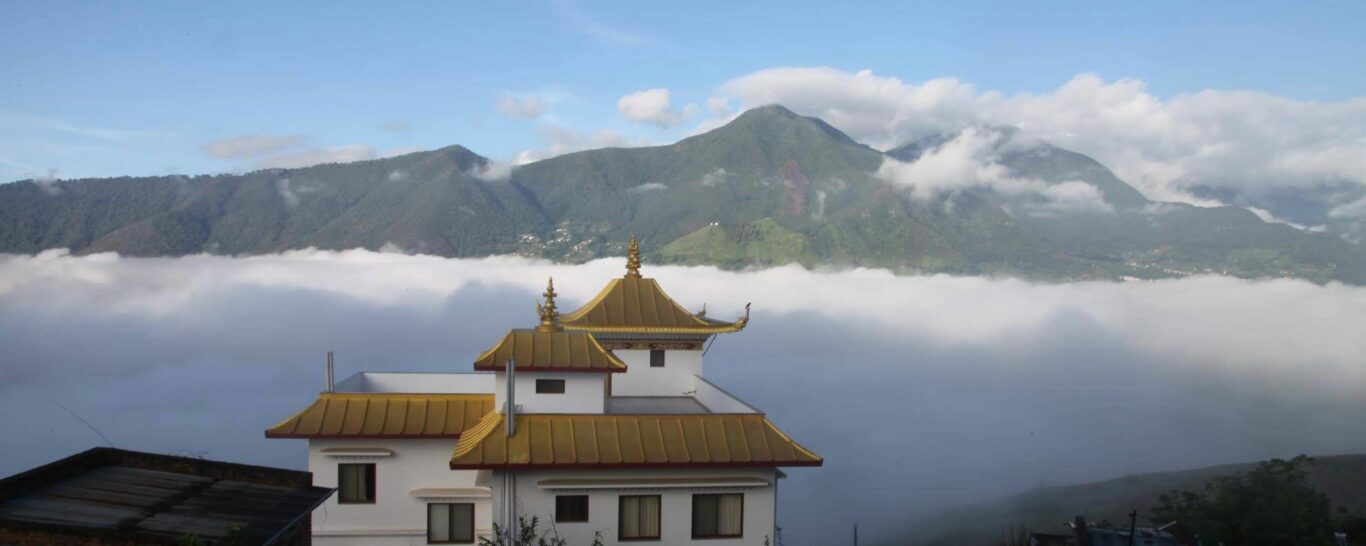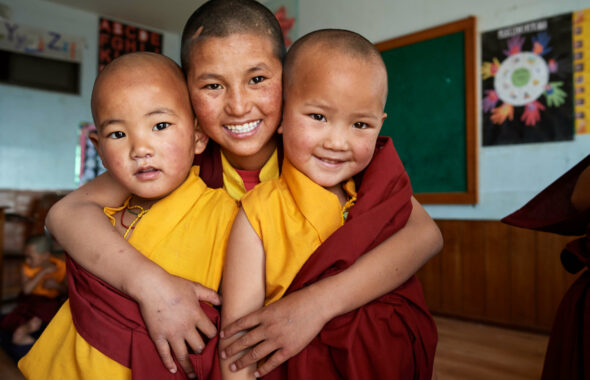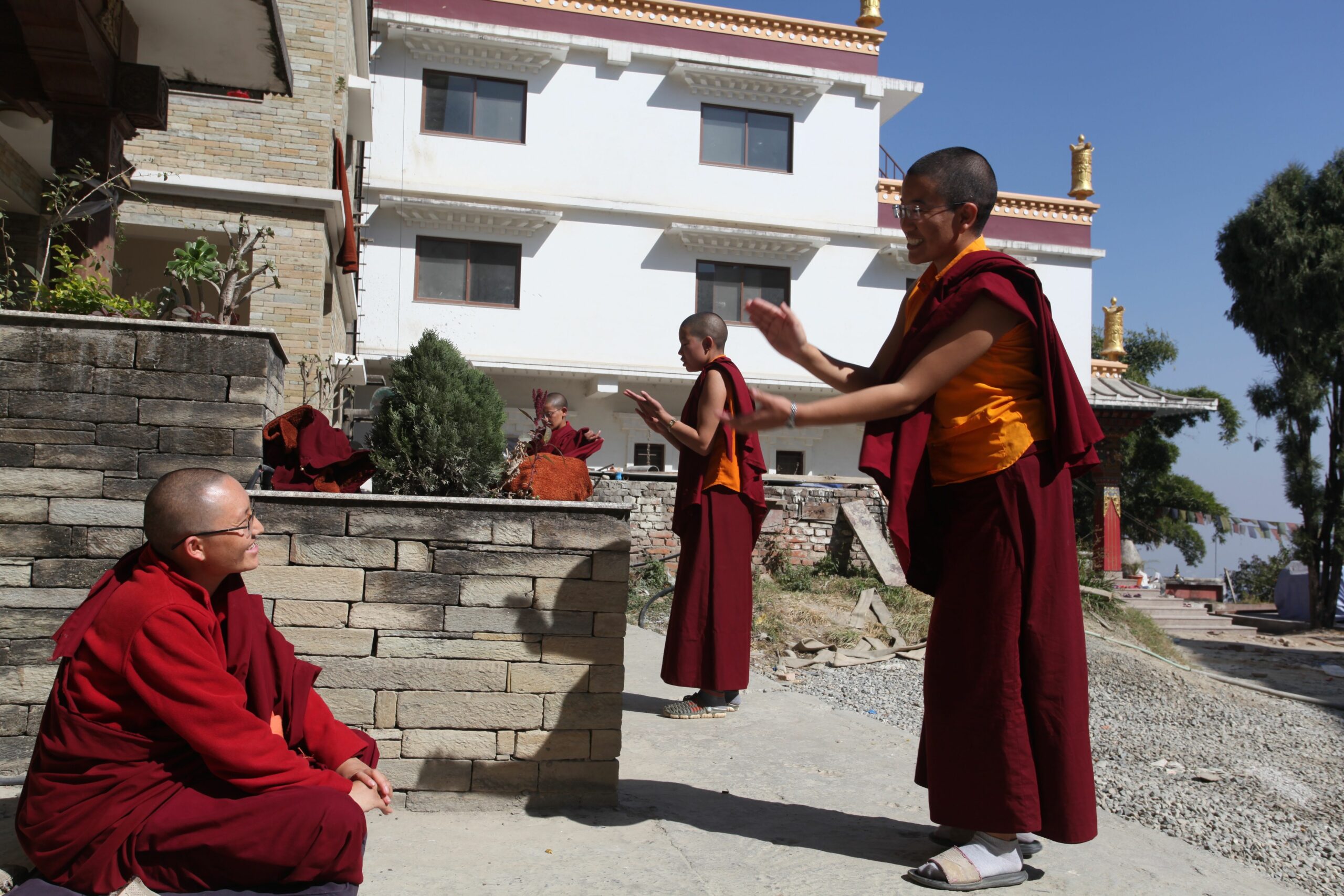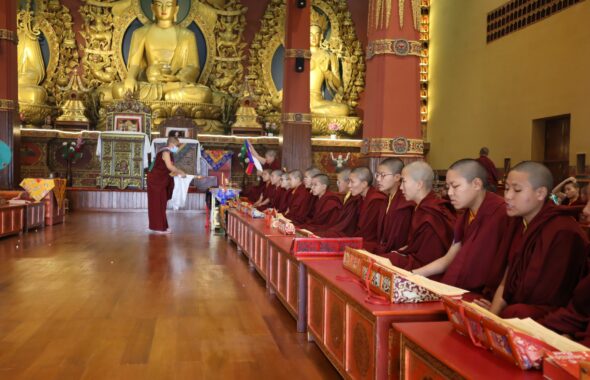Tsoknyi Gechak Ling


Tsoknyi Gechak Ling A Unique Nunnery Practising the Tsoknyi Tradition
Tsoknyi Gechak Ling is the only nunnery outside of Tibet that practises the Tsoknyi tradition. Located in the ancient hilltop village of Chobhar, just outside Kathmandu, this nunnery is situated near the centuries-old temple of Chobhar Adhinath, also known as Anandadi Lokeshvara. This temple is one of the four main temples of Avalokiteshvara in the Kathmandu Valley.
The practice of Avalokiteshvara has deep roots in Chobhar, as it was here in the 9th century that Buddhist nun Gelongma Palmo established the Nyung Nye purification practice, which involves fasting and prayer focused on this deity. The nunnery’s main shrine hall houses an extraordinary image of the thousand-armed Avalokiteshvara, the lord of compassion. The village of Chobhar also overlooks the Chobhar Gorge, where, according to legend, the Bodhisattva Manjushri compassionately cut through the surrounding hills to drain the lake that once filled the Kathmandu Valley, making it suitable for human habitation.
Tsoknyi Gechak Ling was established in the spring of 2010 with approximately 32 nuns and has since grown to house over 150 nuns. Many of the original nuns came from Gechak Nunnery in Nangchen, eastern Tibet, to be with their teacher, Tsoknyi Rinpoche. The nunnery is currently constructing a new home for the Tsoknyi Nuns, further contributing to the rich spiritual history of the area.

Tsoknyi Gechak Ling: A Growing Nunnery with a Rich History and Expanding Facilities
In 1994, the first five nuns arrived in Parphing, a sacred place to Guru Rinpoche located outside the Kathmandu Valley. Tsoknyi Rinpoche rented a house for them, and over time, their numbers grew as new young nuns from Nepal joined them. Under Rinpoche’s guidance, they practised according to the Tsoknyi lineage tradition. By 2009, the community had outgrown their residence, so Rinpoche arranged a larger space and relocated the entire community to Chobhar. Here, he established Tsoknyi Gechak Ling and a shedra (Buddhist monastic college) to complete the nuns’ philosophical education.

In 2010, Rinpoche visited his home village of Samagaon in Nubri, in the mountains of northern Nepal.
He bestowed a public empowerment and inaugurated a joint community and government school. Rinpoche encouraged parents to send their children, including their daughters, to this school. He also shared the news of the newly established nunnery near Kathmandu. In the spring of 2011, 82 young girls arrived in Chobhar to join the nunnery. In a devout Himalayan Buddhist community, like Nubri, many parents still prefer to send their children for a traditional Buddhist education rather than to a secular school. With no space for the newcomers, Rinpoche quickly converted a new administration building into dormitories and built temporary classrooms. By the end of 2011, Rinpoche envisioned building a larger nunnery at the Chobhar location to accommodate the growing number of nuns. In early 2012, a campaign was launched to raise funds from Rinpoche’s students worldwide. As a result, new facilities were built, including a primary school, nuns’ residence, shedra classrooms, three-year retreat building, and a large shrine hall. An international retreat centre and a new school building are currently under construction to accommodate the increasing number of students.

Tsoknyi Gechak Ling Shedra: A Comprehensive Buddhist Education Program
The Tsoknyi Gechak Ling Shedra provides an extensive course of study in Buddhist philosophy, following the curriculum of Namdroling’s Ngagyur Nyingma Institute. The academic year at Tsoknyi Gechak Ling Shedra runs from the beginning of the second Tibetan month to the end of the eleventh Tibetan month. Currently, the shedra has two class groups. The first group graduated in the spring of 2020, while the second group completed their studies in 2021. This comprehensive programme continues to provide a solid foundation in Buddhist philosophy and practice for future generations of practitioners. The nine-year program covers a wide range of texts and subjects, ensuring a deep and thorough understanding of Buddhist teachings. The curriculum encompasses the following elements:
- Years 1-4: The study of five principal Madhyamaka texts, two Abhidharma texts, three Tibetan language texts, and various supplementary texts.
- Years 5&6: The exploration of Maitreya’s five works, Dharmakirti’s Pramana Vritti, an in-depth analysis of the Six Perfections, emphasising Prajnaparamita (Perfection of Wisdom), and numerous other texts.
- Years 7-9: The Advanced Tantra Course, featuring Guna Prabha’s Vinaya treatise, Guhya Garbha Tantra, works by Longchenpa and Jigmed Lingpa, as well as supplementary Vinaya texts.

Pema Chödrön Drubde: A Three-Year Retreat Facility
The Pema Chödrön Drubde at Tsoknyi Gechak Ling is a three-year retreat facility for the nuns. It provides a space for dedicated practice and spiritual growth. It includes a shrine room and individual rooms for each practitioner. The first group of seven nuns began their retreat in the spring of 2017.

The Trasang: General Community and Heart of Monastic Life
In any monastery or nunnery, the trasang represents the general community and serves as the heart of monastic life. When individuals are accepted into the nunnery, they initially become part of the trasang. Based on factors such as age, prior studies, and experience, they may later choose to join the school, shedra (monastic college), retreat centre, or continue their participation in the Trasang.
The trasang plays a crucial role in managing the daily operations and smooth functioning of the nunnery. Among its many responsibilities are the organisation and performance of daily prayers and pujas (religious ceremonies). The trasang works in collaboration with other divisions of the nunnery, creating a cohesive and supportive spiritual community.
Tsoknyi Gechak Ling’s vibrant trasang is composed of various key members, including the Gyeko, who serves as the discipline master, maintaining order and overseeing adherence to monastic rules. The Nyerpa is responsible for managing food supplies and overseeing the kitchen, ensuring that the community’s nutritional needs are met. In addition, several dedicated nuns work diligently to make certain that daily practices are conducted, and prayer requests are completed. These nuns are often assisted by others from the school and shedra, demonstrating the interconnected nature of the different divisions within the nunnery.
